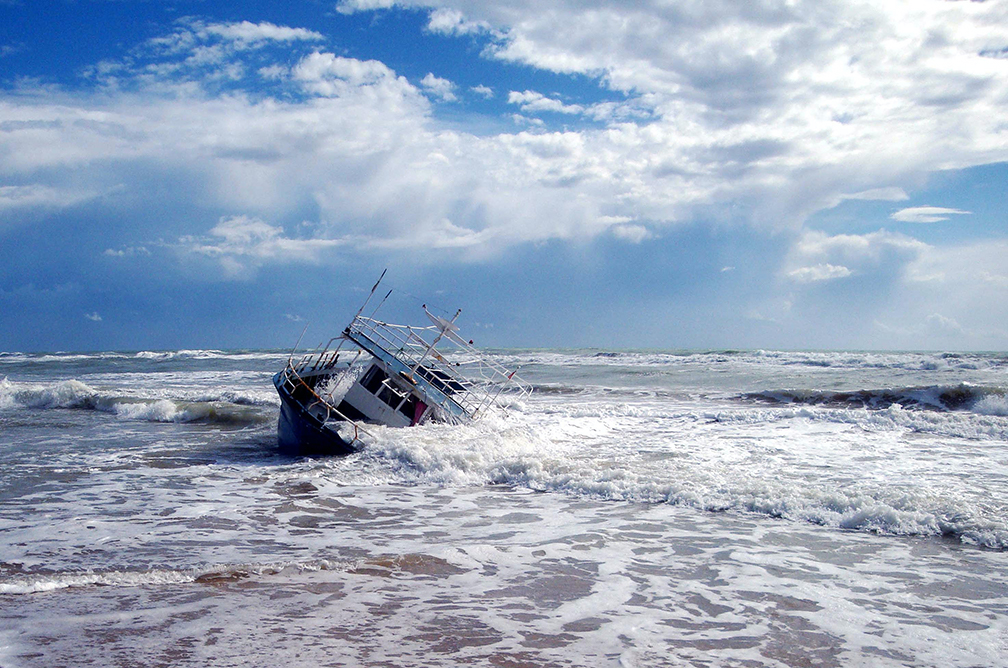(NEW YORK) — Oftentimes, journalists go undercover because there is a danger to themselves if they do not. In the case of writer Luke Mogelson and photographer Joel van Houdt, they went undercover in order to put themselves directly in danger.
More than a thousand people from the Middle East and Central Asia had died on the journey from Indonesia to the Australian territory of Christmas Island when the duo covered “The Impossible Refugee Boat Lift to Christmas Island” in 2013 for The New York Times. Refugees, many of them Afghans, would pay Indonesian smugglers to take them on a treacherous multi-day journey through 200 miles of swelling ocean on wooden fishing boats hardly meant for passengers. These boats were often destroyed mid-journey by “tempestuous” weather, causing those who didn’t drown to drift at sea for days.
Despite attempts from the Australian government to discourage migrants from boarding the boats (even announcing that refugees would be resettled in Papua New Guinea or the Republic of Nauru instead of Australia), hundreds of refugees continued to make the trip. The journalists decided to detail the harrowing journey as accurately as possible — by going on a boat themselves.
Because of a partnership between Australia and Pakistan’s intelligence service that resulted in an increase in undercover agents hunting for smugglers, Mogelson and van Houdt were warned that there was no chance of Western journalists being welcomed abroad. Their solution was to pose as refugees themselves. Because they were both white, they had to devise an elaborate cover, posing as Georgians who were carrying sensitive information about government activity during the Russo-Georgian war (hence their media equipment). They went through the same process as all refugees had to do: setting up a special money transfer to pay the smuggler, hiding out in a safe space in the Indonesian capital of Jakarta for several days, and even a failed first attempt to make it to the boat.
Mogelson and van Houdt could have paid the most literal ultimate price in pursuit of this story: their lives. The authorities who ultimately rescued their boat told them that if they had left a few days earlier, their boat would have capsized.
At the end of the day, the story could have still been written without embarking on the trip themselves. However, what makes the story truly powerful is the accounts from the boat. Technically, the journey on the boat could have been retold through interviews with migrants who had taken it, but who knows if the descriptions would have been as powerful as what Mogelson saw himself? His first-hand writing allows the reader to feel the anguish of the boat ride directly themselves. For example, he describes here their attempts to take cover on the roofless boat:
“The tarp was unfurled. There was not enough of it to cover everyone. If you found yourself on an edge or corner, someone from the opposite side would invariably pull it away the moment you relaxed your grip. In any case, it was too worn and porous to do much. The water ran down its folds and creases, streaming through the many tears along the way.”
In another powerful example, he describes the moment the refugees destroyed their passports when the authorities approached:
“A pair of scissors was passed around. The burgundy covers, emblazoned with the Iranian coat of arms, were cut into tiny pieces. The work was accomplished with flair and relish. Only one man seemed hesitant. Moving closer, I saw that the passport he was disposing of was his son’s. When the scissors came his way, he carefully cut out the photo on the first page and slipped it in his wallet.”
Of course, another essential aspect of this story is the media, and the powerful photos of the migrants soaking wet or in unrelenting physical pain add an even more powerful dynamic to the story that necessitated van Houdt being there.
Stories of migration are told all the time, so much so that there may even be some fatigue when it comes to things like the nightly news reporting on the influx of migrants crossing the southern border at any given time. It’s when these stories paint a colorful picture of the intense human experience that goes along with dangerous migration that media consumers are truly impacted. Sometimes, ethical implications may come into play in order to do this. One powerful example that comes to mind is the photograph of Óscar Alberto Martínez Ramírez and his daughter lying dead. While there have been debates about the ethics of publishing such a graphic photo, many believe it was necessary in order to truly show the human toll that border policies at the time were having. Similarly, the ethics of Mogelson and van Houdt going undercover can certainly be called into question, but I believe that it was necessary to truly capture the situation.
Mogelson’s underlying thread throughout the story is the portrayal of unrelenting hope. Some of this he does by recounting discussions with refugees pre-departure, who refused to believe the possibility of not having a better life after making the journey, even when political tides were turning further against even letting refugees enter the country after arriving on a boat. But the most powerful iteration of this comes from reporting that could have only been done from his eyewitness account from the boat, like where he details one refugee overcome by incredible seasickness: “Siya would not be cowed. Peeling off his soaking tank top, revealing his tattooed wings — seeming to unfold them, actually, as he threw back his shoulders — he began to sing.”


